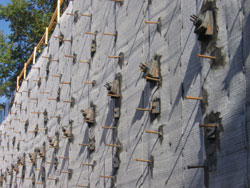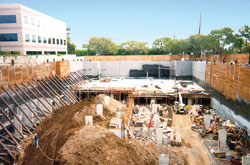Blind Side Waterproofing
WHY BLINDSIDE WATERPROOFING?
- NECESSITY : Most new construction projects in dense urban areas (ie. Downtown Vancouver), have to deal with the fact that either property line encroachment or other space limitations prohibit the excavation of the site. Typical projects also include tunnels such as the Canada Line.
- ENVIRONMENTAL: Blindside waterproofing can substantially reduce the area of a site that needs to be disturbed or excavated. This type of waterproofing limits over-excavation and greatly reduces the developed footprint of the building. Incorporating blindside waterproofing into a project design can help achieve LEED prerequisites or credits for Sustainable Sites-Site Development and other categories.


NOW, WHY TURBO SEAL BLIND SIDE WATERPROOFING?The single most important aspect in blind side waterproofing is the adhesion between the concrete and the membrane. Unlike all the products that are out in the market today, Turbo Seal is the only waterproofing material that will NEVER cure, thus NEVER tearing or delaminating from the concrete. Like human skin, Turbo Seal will respond to all the movements that the structure experiences.
- Application stage. The time period between the application of the membrane and the pouring of concrete varies from project to project. Because the spray-applied liquid membranes will cure upon application, patches of the hardened waterproofing membrane will flake off, leaving unprotected areas.
- Detailing. One of the most important aspect of blind side waterproofing is the detail work around the soldier beams, tie-backs, and other penetrations. Whether bentonite sheets or plastic sheet goods are used, some sort of liquid membrane has to be used on these details. With Turbo Seal, a flexible gel-like material, we can achieve a seamless monolithic protection course on the entire application area.
- After Completion. With Turbo Seal, there is no reliance on the risky “mechanical bonds” of the sheet membranes or dependence of heat from the pouring of concrete to adhere the membrane to the concrete. Over time, all types of hardened membrane will ultimately de-bond from the concrete, causing multiple leakage issues.
In the following clip, a chunk of concrete is broken off of the mock-up to make sure there is waterproofing coverage on the surface. Turbo Seal, which stays in a gel-like form, will provide protection without delamination in blind-side waterproofing
